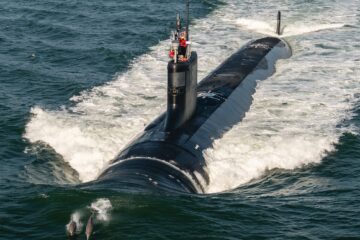The US Navy is scheduled to lose all four of its Ohio-class SSGN in the coming years. The move to finally retire the four guided missile submarines has been long anticipated, but it is now only two years away according to the Navy’s recently issued 30-year shipbuilding plan.
The first two boats – USS Ohio (SSGN-726) and USS Florida (SSGN-728) – are scheduled to join 17 other ships planned for retirement in 2026. With the Navy retiring the remaining ships, USS Michigan (SSGN-727) and USS Georgia (SSGN-729), in 2028.
These four submarines are the oldest of the Navy’s Ohio-class submarines, all of them pushing more than 40 years of service.
Following the 1994 Nuclear Posture Review (NPR), the number of SSBN in US inventory was downsized from 18 boats to 14. The four retired vessels would be converted into guided missile submarines. This process lasted from 2002 to 2007, with the last boat, USS Georgia (SSGN 729) completing her conversion in December 2007.
The conversion process for these boats traded 24 missile tubes that held Trident Submarine Launched Ballistic Missiles (SLBM) for 22 missile tubes holding seven Tomahawk Land Attack Missiles (TLAM) each, for a total of 154 missiles.

Moreover, the converted submarines were also given the space and necessary changes to host up to 66 Special Forces (SOF) personnel and two missile tubes modified to lockout-out chambers for Dry Deck Shelter (DDS).
Lastly, the conversion resulted in these vessels trading their SLBM control related facilities for the Common Submarine Radio Room (CSRR) and two High-Data-Rate antennas. These two changes greatly expanded the communication capabilities of the vessels. As such, each of these four ships has the necessary systems to act as a forward-deployed, Small Combatant Joint Command Center for the Special Forces onboard.
These four submarines currently make up nearly half of the vertical launch payload capacity of the Submarine Force. As such, the Navy will see a sharp decline in available payload capacity immediately after the first two boats are retired.
The Navy, anticipating the retirements of these vessel, has initiated the procurement of Block V Virginia-class submarines. These boats receive the 84-foot-long “Virginia Payload Module” that holds four large diameter vertical launch tubes.
These vertical launch tubes are similar to the “Multiple All-Up-Round Canister” tubes on the Ohio SSGNs and can each hold seven Tomahawk missiles, for a total of 28 additional missiles on each boat.

The Navy needs to procure 22 of these VPM equipped Virginias to regain lost payload capacity. However, recent delays caused by the Covid-19 pandemic have pushed back the delivery schedule of these submarines.
The delays have also been exacerbated by the construction of the Columbia-class ballistic missile submarines, which are meant to replace the aging Ohio-class submarines.
Due to their role, these vessels are the Navy’s number one priority. As such, industry has been redirecting all available manpower into the Columbia program to ensure that it remains on schedule.
These issues will further delay the replacement of lost payload capacity in the Submarine Force. This leaves the US Navy lacking capacity in an area that is extremely crucial.
While the idea has been floated multiple times, it currently remains unclear whether or not the US Navy will procure dedicated SSGN hulls based on the Columbia-class submarines.
If such a hull were to be procured, it would not see service until the mid 2040s. This is due to Columbia production extending out to 2041 for the last boat of the class.






